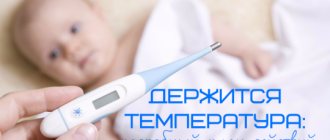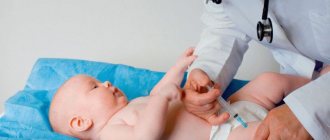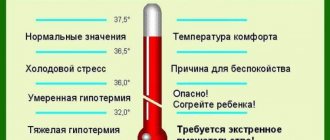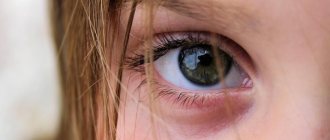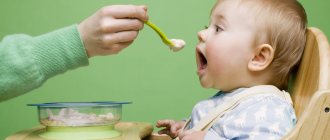1. Accidentally touching the fontanelles on the baby’s head
Despite doctors' warnings, you should not become hysterical if you accidentally touch these soft spots on your newborn's head. By the way, these places are called fontanelles. And when you touch them, you are not touching his brain. What are you touching then? The so-called membrane, consisting of dense connective tissue. The soft areas on the head are designed to allow the baby to move freely through the narrow birth canal. Thanks to the flexibility of the skull, this tiny head has already survived quite a traumatic journey without any harm, so your gentle touch will not harm it. And the fontanelles will heal sooner or later.
2. Pulsation in the fontanelles
When a child screams or plays, you can see pulsation of the brain vessels in the anterior fontanel. Don't panic. The fontanelles are located in areas of the skull that have not yet fused, and veins and arteries can sometimes be seen through the soft membrane. And pulsation is a normal development of the child’s circulatory system.
3. Blood in the diapers of a newborn girl
During pregnancy, a surge in maternal estrogen levels can stimulate the unborn baby's uterus. Therefore, some newborn girls experience a small amount of spotting during the first week of life. There is nothing wrong with this hormonal surge.
4. Small depression in the baby's chest
Relax – these are not heart problems. According to experts, the sternum consists of three parts. The indentation that is sometimes noticeable in some babies is most likely an inverted lower part of the sternum. As the child grows, the growing muscles of the chest and abdomen will straighten this depression. But, perhaps, even before this, the layers of growing fat will be leveled off the chest.
5. Loose stools after every feeding
Breastfed babies may have a bowel movement after each feeding because breast milk is digested very quickly. By the way, newborns who are bottle-fed may defecate less frequently. As for the consistency of stool, there is nothing surprising in this either - all babies are on a liquid diet.
6. Constant hiccups
Experts cannot agree on why newborns hiccup so often. Some believe this is because the brain and the diaphragm, the abdominal muscle that controls breathing, are still working somewhat inconsistently. However, regardless of the cause, hiccups are harmless and safe.
Babies have immature nervous systems and are easily startled. These are two reasons why they shed tears so often. In addition, crying is the only way a baby can communicate its needs and needs. So up to a certain point you are doomed to see tears and listen to screams. Don't worry about the baby - although he looks upset, the baby is not harming himself.
8. Rash or pimples on the face
Thanks to maternal hormones still circulating in small bodies, newborns often develop acne. As a rule, the rash goes away over time - from 2 weeks to 2 months. What to do? Just wash your baby gently and gently. There is no need to use your anti-acne gels and creams.
9. Swollen breasts
The same hormones that cause mini-periods in girls (see point 3) can cause swelling of the mammary glands in newborns of both sexes. Marvelous? Yes. Temporarily? Absolutely right. Exciting? In no case.
10. Endless sneezing
Babies have tiny noses. And even a tiny piece of stuck mucus, even a slight nasal congestion, can cause a baby to sneeze. And so time after time. If the sneezing is not accompanied by thick yellow mucus, which can signal that the baby is cold, then the newborn will simply outgrow this condition over time.
The child fell and hit his forehead
Even if the baby grows up a little, the child’s restlessness often leads to a bump on the child’s forehead from a strong blow. In most cases, this injury does not pose any particular danger - it causes swelling of the soft tissues in the affected area. After a blow, blood seeps out from damaged vessels and accumulates at the site of the injury. Thus, a hematoma is formed.
If a child hits his forehead, the bump will be large, since there is a network of small blood vessels in this area. Some parents immediately call for medical help in this case, but often you just need to not panic.
If a child falls and hits the floor with his forehead, then this is less dangerous than if he did it with another part of the head (back of the head, crown or temple), because this part of the head is the most resilient.
But you need to keep in mind that different situations have different degrees of danger. The younger the baby, the more harm the injury can cause to his health. If this is a newborn child, then you need to call a doctor immediately, and we will look at what should be done in other cases in this article.
Precautionary measures
On the one hand, nature has made babies resilient. On the other hand, the baby’s head and cervicothoracic region are quite fragile. Here's what parents need to remember so as not to harm their child.
You need to take the baby in your arms so that his head does not “loop” around. Always support him under his head, do not lift him by his arms or shoulders. The fact is that the vagus nerve, which regulates many body functions, runs not far from the baby’s occipital bone. If the baby experiences a displacement in this area and the nerve is pinched, this will manifest itself in a variety of symptoms: from problems with bowel movements to problems with motor development. For the same reason, in the first two to three weeks, it is better for early swimmers not to do figure eights and other exercises with the baby that can cause displacement in the cervicothoracic region.
The baby can be carried in a sling, where his head is held securely, and for transportation in a car you need to use a special car seat. But a kangaroo backpack, the back of which does not secure the head and neck, cannot be used until the baby holds his head completely confidently, like an adult.
Remember that nature has provided all possible ways to protect the brain from possible injuries, and has also built into the crumbs a huge resource for the body’s self-healing. Breastfeeding, skin-to-skin contact, positive emotions - all this greatly helps the baby overcome the stress of childbirth.
Alarming symptoms
After a child has hit his forehead hard, a medical examination and consultation with a specialist is still needed. But first, parents should independently assess the condition of the baby’s injury. To do this, adults must carefully monitor him.
There are certain signs that indicate a concussion. You should be alert to the following symptoms, which should prompt an immediate visit to the doctor:
- A depression appeared on the affected area, not a lump.
- The baby feels sick and vomits.
- Behavior has changed: excessive calm or very pronounced irritability has appeared.
- Drowsiness occurred, heavy breathing appeared during sleep, and the skin became unnaturally white and the lips turned blue.
- The baby cries constantly.
- The pupils have become different in diameter or squint has appeared.
- Convulsions occurred.
- The child's temperature has risen.
- The baby experiences pain when bending his head, standing up, or moving.
- The child lost consciousness.
- The baby started bleeding from her ear canals and nose.
- The lump is growing rapidly.
- A small child spits up a lot and refuses to eat.
- Slow heart rate - should be about 100 beats, and in an infant - up to 120 beats per minute.
If a child is injured in the evening, he should not be immediately put to bed, even if it is already bedtime. You need to distract the baby and observe him to determine the severity of the injury.
If the baby exhibits any of the above signs, parents should call the emergency room. These symptoms indicate severe brain injury.
It must be remembered that some of them may not appear immediately, but over the course of 24 hours or later, so during this period your baby needs increased attention from adults.
The result of the blow may be a concussion or a crack in the skull, but only a doctor can accurately assess the child’s condition using x-rays or ultrasound.
In case of severe or undiagnosed injury, the patient requires special conditions for therapy. For a child who is not examined in time, the recovery period is prolonged, and the likelihood of complications increases.
Compression and decompression
Mothers who are preparing for childbirth on their own or in courses for pregnant women have probably seen illustrations of the birth canal and imagine what a difficult path a child has to go through before being born. Nature has provided for everything: the structure of a baby’s skull is completely different from that of an adult. He has fontanelles, the bones of the skull are mobile due to the fact that all their joints are quite elastic, and thanks to this, during the birth process, the baby’s head is easily configured, adapting to the birth canal. Compression occurs. Of course, displacement of the skull bones is possible in this case, but, fortunately, nature has also provided the opposite mechanism - decompression, which turns on immediately after birth.
First aid
A small child often falls and hits his forehead. If a child gets a lump on his forehead, then the following occurs on the affected area:
- swelling up to 5 cm;
- wound or abrasion;
- a hematoma (when the walls of blood vessels under the skin are damaged) appears an hour or two after the impact;
- painful sensation at the site of the injury.
When a child has a bump, adults conduct an initial examination and provide first aid. A few minutes after the blow, a compress is applied to the bump. Cold should be applied before soft tissue swelling occurs.
Treatment of a bump on the forehead from a blow
All parents know that they need to be vigilant when caring for their babies, but in practice it is not always possible to keep an eye on them.
After the baby is hurt, a compress is placed on his forehead. This can be either a clean cloth soaked in cold water or ice wrapped in gauze.
Apply a compress to the affected area for 10-15 seconds. Then they take a short (5-10 seconds) break and press again. If there is neither water nor ice, then use those cold objects that are at hand. This could be a frozen piece of meat, a chilled bottle or a tablespoon. This manipulation is performed for about 15 minutes. If everything is done correctly, the lump will not grow, and the hematoma will decrease.
There is no need to pour cold water on the injured area on the child’s head, as this will not have a positive effect. As a result, instead of helping, you can get a cold.
After a bruise, parents should remain calm, otherwise anxiety can be transmitted to the baby, and it will be difficult to calm him down.
If a child hits his forehead and a large bump appears, then, in addition to immediately applying a compress, a number of other measures need to be taken. We will look at them later in the article.
Traditional treatment
When blood accumulates under the skin after a bruise, parents have a question about how to anoint the bump on the child’s head. Provided that there are no alarming symptoms, the bruise can be treated with special ointments and other drugs that reduce swelling.
They have absorbable and anti-inflammatory, and some of them have anesthetic properties. Therefore, after treatment the patient feels much better.
The medicine is applied directly to the hematoma on the forehead with light movements. The bumps are usually very painful, so handling must be done very carefully.
The procedure for applying the drug is repeated 2-3 times every day. Treatment with one medicine should not last more than 5 days. Sometimes the bump on the forehead does not go away during this time. In this case, replace this medicine with another drug or wait for it to go away on its own.
When the bump on the forehead has turned into a bruise, you can already apply heat. It helps to activate metabolic processes and speed up the final recovery from the bruise. Depending on the severity of the damage, the lump can resolve from 7 to 30 days.
When, in addition to the hematoma, there is a bleeding wound with torn edges, then compresses cannot be applied. In this case, the damaged area is treated. This will help avoid infection. Then they go to a medical facility.
By the third week, the hematoma should have disappeared. If this does not happen, then a puncture may be necessary. Over time, a scar may appear in place of the bump. An ointment that softens scars will help reduce the intensity of this process.
Traditional treatment
At home, lump treatment can be done using homemade recipes. Here are the most common ones:
- Burdock or cabbage - they have anti-inflammatory and antiseptic properties. The leaves should simply be applied to the affected area of the head and secured with a bandage. You can also chop the cabbage and wrap it in gauze. By applying it to a bruise, you can get a pronounced resolving effect.
- Bodyaga. This product comes in two forms: powder and gel. The last form is completely ready for application to the bruise. If powder is used, it must be diluted with water 1:1 before use. Then the entire surface of the cone is covered with the pulp. Leave the medicine for up to 20 minutes, then wash off with water. Do a similar procedure 1-2 times a day.
- Boiled bay leaves. To prepare, you need to take leaves (3 pieces) and boil them for 5 minutes. After this, they are allowed to cool slightly and, while warm, are applied to the affected area.
- Potato starch. Take 2 tbsp. l. substances and diluted with water until the consistency of sour cream. This remedy should be applied to the bruised area. After some time, wash it off. Repeat a couple of times a day until complete recovery.
- Laundry soap. It is grated on a fine grater and egg yolk is added to it. For 1 yolk take 1 tbsp. a spoonful of shavings. Treat the cone with the resulting product every 3 hours. You need to wash it off before going to bed.
- Banana peel. Remove it from the banana, place the inside on the injured area and hold for 5 to 15 minutes.
- Butter. Melt it in a water bath and lubricate the swelling every 30 minutes.
- Instead of regular ice, you can apply a frozen decoction of string, chamomile, or sage to the cone.
- Iodine. It is applied to the site of the injury in the form of a mesh. The procedure is repeated for several days.
All these simple recipes can help treat a bruise, so if necessary, you can use the most suitable ones.
Children differ from adults in their mobility. Therefore, a forehead bruise in a small child occurs more than once until he grows up. If the lump is not very pronounced, then most often there is no need to treat it, since in most cases it goes away without a trace. In case of severe injury, it is advisable to consult a doctor.
The most effective way to prevent childhood bruises is to talk about safe behavior. The child needs to be told in a gentle and accessible way how to behave correctly. But if trouble does occur, then now parents will be aware of the symptoms that require immediate medical attention. In other cases, adults will choose effective methods for quickly healing bruises.
Although mothers want to protect their children from injury, this is not always possible. Babies are active and mobile, they cannot sit still, so a lump on a child’s forehead is not uncommon. Parents must understand how to act in such a situation, what to pay attention to, what ointment will speed up resorption.
Cold compress - first aid for shocks
First aid if a child hits his forehead
Most often, a noticeable bulge on the head is a hematoma that appears after a blow. There are a large number of small vessels on the forehead. When they burst, the soft tissues become saturated with blood and begin to bulge. Most often, such injuries do not have consequences, because the bone here is very strong. It is more dangerous if the little one hits the back of the head or temple.
If a child falls, flying into a sharp corner, for example, and a hematoma forms on the forehead, parents must remain calm. Their task is to take urgent action. If there is no wound, then first aid after such a fall is to apply cold ice to the site of the bruise. It could be a simple metal spoon. Better yet, take ice or some frozen food out of the freezer. This compress should be made carefully, after wrapping it in a towel or napkin. Under the influence of low temperature, the blood vessels will narrow, and the swelling will not be large.
There is no need to pour cold water on the baby's head. This will do nothing except cause hypothermia, which could cause the baby to catch a cold. A cold object must be pressed tightly to the damaged area on the head and held for a quarter of an hour.
If a child has a bleeding abrasion on his skin, it should be treated with an antiseptic. This will help prevent infection. If the wound is deep, it is better to go to the emergency room.
Dimple on the chin
Facial dimples in the central part of the chin also adorn the face.
By its presence one can judge a lot about a person. The main manifestations of such a personality are importance and solidity, calm confidence, impressiveness, respectability and poise. Such people are often attractive with their leisurely gait and good-natured smile. They often patronize the younger ones, help those who turn to them for help, and love company. They prefer to dress in the most prestigious and fashionable clothes, but they do not have any particular taste and are slightly sloppy. This person does not tolerate competitors, he is proud, which he carefully hides. The opinions of others are very important to him; he values his impeccable reputation.
In achieving their goals, such people are persistent, they know how to see the general, without worrying about their own benefit, and do not dwell on the details.
Among the negative character traits of a person with a dimple on the chin are pride, promiscuity, boastfulness, complacency, wastefulness, and hypocrisy.
What can I do to make the bump go away faster?
But it happens that it was not possible to apply ice in time and literally within a few minutes after the blow a huge lump formed on the forehead. If you do nothing, it will take a very long time, perhaps several weeks. Therefore, it is worth using an ointment that will help the swelling quickly resolve. This must be present in your home first aid kit. These can be “Troxevasin”, “Lioton”, “Rescuer”, “Ambulance”, “Traumel” or other drugs.
After the child gets a bump on his head, first apply cold and then apply ointment. Take a little product from the tube onto the bruised area and rub it in with light movements. This must be done carefully so as not to cause pain. The procedure is carried out two or three times a day, the duration of the course should not be more than five days.
If a bump pops up on your head, you can turn to folk recipes. Bodyaga helps with bruises on the forehead. Lotions are made from it to remove swelling. Cabbage leaves have absorbent properties, as do burdock and plantain. They are crushed and wrapped in a bandage before applying to the affected area.
Dimple at the tip of the nose
A dimple at the tip of the nose indicates plasticity, variability, adaptability, instability in judgment, sensitivity, receptivity, impressionability. A person with such a dimple tends to coordinate his behavior with those around him. He is often not collected and does not like discipline, is dreamy and capricious, and extremely impulsive.
People with a dimple at the tip of their nose are sentimental, gravitate towards home, family, home, parents, because they are not too independent, they like to be taken care of, they are very attached to children, younger brothers, sisters, they themselves love to take care of them . For all their vulnerability, such people have a tenacious will to live, the ability to survive, rise after the most difficult life crises, come to their senses and start all over again.
Negative character traits include laziness, lack of composure, hysteria, slowness, absent-mindedness, and optionality.
Alarming symptoms
Usually, a lump that a child gets will go away quickly if you use ointment, and without consequences. But sometimes the impact of a fall is too much. Therefore, it is necessary to carefully monitor the baby’s well-being. If suspicious symptoms appear, you should immediately go to the hospital. These include the following signs:
- pain that does not improve;
- weakness, the baby tends to sleep;
- there is a dent on the forehead, not a bulge;
- the child feels sick and vomits;
- bleeding from the nose or ears;
- the baby loses consciousness, even if only for a short time;
- strabismus appeared, the pupils became unequal in size;
- the child looks pale, the nasolabial triangle turns blue;
- the hematoma does not go away for a long time, even if ointment was used.
Some of these signs are noticeable right away, others may appear later. In this case, a concussion cannot be ruled out. A doctor will be able to determine this more accurately using an ultrasound or x-ray. He will give recommendations on what to do next. If the hematoma does not heal for a long time, a puncture may be required to remove the contents.
Diagnostic methods
Examination of the brain through the greater and lesser fontanel
A dent in the forehead can occur for various reasons, some of which can be dangerous to health. Therefore, if this symptom is detected, it is necessary to contact a medical facility as soon as possible, especially if the following symptoms are present: dizziness, disorientation, nausea.
If a depression on the forehead appears due to a head injury, it is necessary to carry out a diagnosis as soon as possible. Some injuries, including skull fractures, can be life-threatening.
In some cases, a simple examination and study of the medical history is sufficient to make a diagnosis. In difficult situations, various tests may be needed, for example, MRI of the skull or CT scan, which will make it clear whether the bone at the defect site is intact, whether the patient has pathologies and other possible causes of dents. All these diagnostic methods help to make an accurate diagnosis and prescribe adequate treatment.
For what other reasons can a lump appear?
A lump on a child’s forehead does not always form after a blow. There are other reasons, for example, structural features of the skull, often hereditary. There is no cause for concern. No ointment will help you get rid of the bulge in a short time, but with age it will become almost invisible.
Sometimes a bump on the forehead occurs due to blockage of the sebaceous glands. Such a wen can change appearance and increase in size. It happens that this leads to suppuration. This problem should not be solved on your own, as the risk of infection is high. A specialist will be able to get rid of the growth using cryodestruction. During this procedure, the tumor is destroyed by cold. In the future, it will be necessary to monitor the cleansing of the child’s skin to prevent relapse.
Fibroids may also appear on the scalp. This is a benign formation, and if it is small in size, then it is not touched. The lump may turn out to be an abscess. In such a situation, the pediatrician should prescribe treatment. Usually it includes antibiotics and restorative therapy, taking vitamins. Sometimes surgical intervention is unavoidable. In rare cases, it turns out that a lump on the forehead is not an ordinary hematoma, but a more dangerous disease - a hemangioma or melanoma. The effectiveness of treatment depends on how early it was started.
Blows and injuries in children are inevitable, including on the head, because children are actively exploring the world. Parents should be prepared for such situations so as not to fall into a state of panic, and the first aid kit should have the necessary medications. Including an antiseptic and an ointment that promotes the resorption of hematomas.
Once a child begins to walk, falls and injuries become commonplace for parents. Often, a child hits his head while playing - this can be a collision with an obstacle while running, hitting the corner of a table, falling on the floor or asphalt. Babies also often get bumps and bruises as soon as their mother turns away for a second. As a rule, such situations frighten parents, and they call a doctor in panic. How to determine how badly a child is injured, what to do first and when to sound the alarm - we will consider below.
Inspection of the injured area and first aid to the child after an impact
If a child falls and hits his head, an initial examination should be performed immediately. A hard landing on the asphalt may be accompanied by external damage - scratches, abrasions on the forehead. In this case, they should be treated with hydrogen peroxide. If the skin is not broken, the injury is assessed in stages:
- The lump indicates a bruise of the soft tissues of the head. As a rule, in children it disappears within 1-2 hours.
- A hematoma may form at the site of injury - its appearance indicates damage to the blood vessels. However, a bruise can also occur due to a crack in the skull, which is much more dangerous.
- Severe bleeding and a deep wound are a reason to call an ambulance.
After examining the bruise, ice should be applied to the child's forehead. Its pieces should be wrapped in a clean cloth (handkerchief) and pressed onto the affected area for 10-15 seconds. Then take a short break (5-10 seconds) and press again. Instead of ice, you can use a chilled spoon, frozen meat or other cold object. The procedure should be carried out within a quarter of an hour. Usually these actions are enough for the lump to disappear, and the hematoma to become smaller and resolve faster.
After hitting your head, you should briefly apply a cold compress to your forehead. Associated symptoms after hitting your head.
If the head impact was not too strong, there may be no associated symptoms at all. In case of an unsuccessful fall, the following manifestations are possible:
- Redness of the skin.
- Abrasion or wound.
- A lump is a swelling at the site of impact measuring 3-5 cm. A larger size requires the intervention of a specialist.
- Hematoma is a bluish discoloration of the skin caused by damage to blood vessels. A bruise, unlike a bump, does not appear immediately, but within 1-2 hours after the incident.
- Pain at the site of the injury, aggravated by pressure.
- Sometimes, 2-3 days after hitting the forehead, the child develops blue discoloration under the eye above which he received the bump.
What signs should you sound the alarm about?
In addition to examining the site of the injury, the general condition of the child should be assessed. If a baby hits an open door and cries, this does not mean that the injury is serious. Children are often frightened by an unexpected blow, so you need to try to calm and distract the baby. However, the consequences of a blow can also be a concussion or a crack in the skull.
If the blow was severe, the child should be shown to a doctor, so that he, in turn, can assess the severity of the blow and prescribe the necessary treatment.
It is important not to panic, but to pay attention to the following signs:
- Pupils. Their size should be the same; if one is smaller than the other, a concussion occurs.
- Unusual child behavior. If the baby is too lethargic after a fall, begins to yawn, becomes sleepy, or has short-term loss of consciousness, he should definitely be shown to a doctor.
- Another sign of a concussion is nausea and vomiting. In a small child, this symptom may manifest itself as regurgitation, and it will become difficult to eat.
- It is necessary to measure the baby's pulse - it should be within 100 beats per minute, for an infant - 120. Slowing the heartbeat is an alarming signal.
- After your baby hits his forehead, his temperature may rise. This situation also requires contacting a specialist. To rule out a crack in the skull, your doctor may recommend taking an X-ray of the head. The pediatrician will also refer you for consultation to a neurosurgeon and ophthalmologist.
- Some doctors do not advise putting your baby to bed right away, even if it is time for bed. This recommendation is due to the fact that it is easier to observe the child while he is awake in order to notice deviations in his behavior in time. It’s worth trying to distract him from what happened and take a closer look at how the baby behaves.
Treatment of a bump on the forehead
Sometimes a lump on a child’s forehead becomes alarmingly large and does not disappear immediately. It is believed that the frontal bones are one of the strongest, but it is still better to show the child to a specialist in order to avoid consequences.
If the doctor does not find any serious abnormalities in the baby (cracks in the skull or concussion), the large lump can be treated at home. However, it is important to ensure that secondary infection does not occur - suppuration does not form. Let's look at what parents should do and how to cope with the problem on their own.
Ointments and other drugs
In order to speed up tissue regeneration processes, damage on the forehead can be lubricated with ointments and gels that have absorbable and anti-inflammatory properties. It’s good if the product has an anesthetic effect, then the pain from the bruise will go away faster. Our table contains the most popular and effective means for external use.
| Drug name | Compound | Indications | Recommendations for use |
| Traumeel (gel or ointment) | Homeopathic remedy, contains extracts of yarrow, aconite, mountain arnica, belladonna, etc. | Injuries of various origins (sprains, dislocations, hematomas), inflammatory processes in the joints. | Apply a thin layer to the affected area 1-2 times a day. Use no more than 10 days. |
| Balm Rescuer | Milk lipids, beeswax, tea tree oils, sea buckthorn, lavender, echinacea extract, tocopherol, turpentine. | Abrasions, wounds, diaper rash, hematomas, bruises, sprains, skin infections, inflammatory processes on the mucous membranes. | Apply the balm to cleansed skin. It is advisable to use a bandage with an insulating layer (for example, seal it with a bandage). |
| Gel Troxevasin | The active ingredient is troxerutin. | Swelling and injury, muscle cramps, venous insufficiency. | It is not recommended to apply to mucous membranes. |
| Gel BruiseOFF | Leech extract, pentoxifylline, ethoxydiglycol, etc. | Bruises and bruises on the face or body. | Apply to affected areas up to 5 times a day. Do not use on mucous membranes. |
Folk remedies Boiled bay leaves are a good auxiliary remedy
There are also folk remedies for eliminating cones and hematomas. We have selected several recipes that can be used to treat a child:
- Bay leaf. You need to take 2-3 bay leaves and boil them for 5 minutes. Then apply the cooled leaves to the bruise for a few minutes. If the leaves are warm, the effect may occur faster.
- Potato starch will help get rid of a huge lump. To prepare the product you need to take 2 tbsp. l. starch and dilute it with water to the consistency of thick sour cream. Apply the resulting ointment to the bump and wash it off after a while. Use until completely absorbed.
- Grate ordinary laundry soap on a fine grater, mix 1 tbsp. l. shavings with egg yolk. Apply the resulting mixture to the bruised area every 2-3 hours. Wash off at the end of the day.
- Apply the inside of a banana peel to the injured area for 5-15 minutes.
- Brush the formation with melted butter. Repeat the procedure every half hour.
- You can apply not ordinary ice to the site of the bruise, but frozen water with the addition of chamomile, string, and sage.
Some folk recipes recommend adding finely chopped parsley to ice.
How long does it take for a hematoma to disappear after an impact?
If a child hits his forehead, a lump may appear at the site of the injury, which will resolve within 1-2 hours. However, there are cases when the compaction does not go away for a long time - up to several days or even weeks. Very rarely, complications arise after an injury, and the lump does not go away without the intervention of a surgeon. The doctor may recommend performing a puncture - using a syringe to remove the contents of the tumor. However, first you should try to get rid of the hematoma on your own.
If a child gets a bump on his forehead, there is nothing wrong with that. The child hit his forehead, and the lump rapidly increases in size. If a child hits his forehead and a lump appears at the site of the injury before your eyes, then you can take certain measures and not allow it to “grow” at all. A hematoma on a child’s forehead can be treated using similar methods.
The cub (1 year and 9 months) has a huge bump on his forehead. Everything would be fine, but it hasn’t gone away for a month now! Bruising occurs very quickly, within a few minutes after the impact. But if you take action very quickly, the bump on the child’s forehead will not have time to grow. It has been tested many times: a large bump from hitting a child with the forehead will go away much faster if you make an iodine mesh. It is necessary to apply cold so that the blood vessels narrow and the blood stops, in order to limit a hematoma on the child’s head if it begins to form.
Shape and size of a newborn's head
The head shape of newborn babies can be not only round, but also elongated, flattened, ovoid - and all these options are considered the norm. Why is this happening?
By the time they are born, the skull bones of babies are not yet very dense (they will have to completely harden during the first year of life), and the seams between them have not yet had time to heal. During birth, the bones overlap each other, allowing the baby to move out more easily. That is why, after a natural birth, the shape of the head is, as a rule, slightly elongated, while in small “Caesareans” it is smooth and round. Due to the vicissitudes of traveling through the birth canal, a baby may be born with an asymmetrical head, and sometimes also with a lump (cephalohematoma) or edema (the so-called birth edema).
At birth, the baby's head is approximately 2 cm larger in circumference than the chest. But it happens that these sizes increase even more: this happens if cerebrospinal fluid accumulates in the cranial cavity. Then the upper part becomes larger than the lower part, a heavy forehead hangs over the eyes and nose, and doctors talk about hydrocephalus. This problem can arise if during pregnancy a woman suffered a severe infection that affected the unborn baby. In this case, doctors will immediately begin treatment of the child, and in a few months his head may approach normal size.
The situation is considered more serious when the newborn, on the contrary, has a too small head (microcephaly). Sometimes this happens due to genetic disorders that will prevent the baby from developing normally. Fortunately, in many cases the reason for the unusual shape or size of the head turns out to be much simpler: the child can inherit all these features from his parents.
Only a doctor can correctly assess the baby’s head circumference, so there is no point in parents arming themselves with a centimeter themselves. But this indicator will tell specialists whether the child’s brain is developing correctly.
Normally, newborns have a head circumference of 34–36 cm. At first, the head grows quite quickly, by about 1.5 cm per month; after 3 months - by 0.5–1 cm and by 6 months it reaches 43 cm in girth. If the baby is far ahead of the norm or behind it, this may indicate problems with the nervous system.
A child has a lump on his forehead - how dangerous is it and what should be done?
Usually, after a fall, all you need is a damp cloth to tidy up your palms and knees, but sometimes the consequences are more serious - a bump appears on the child’s forehead. Regardless of whether the child has a bump on his forehead or not, after the injury we recommend showing the baby to a specialist. Remember, if a child has a bump on his forehead or on the back of his head, then under no circumstances pour cold water on his head!
A hematoma is an accumulation of blood in the upper layers of the skin due to damage to blood vessels. Light hematomas do not appear immediately and occur in various areas of the face with minor mechanical impact.
The first aid for treating a hematoma is a cold compress. Preparations for resorption of hematomas on the face - Girudalgon, heparin ointment and Bruise-off. How to remove a hematoma under the eye? You can cure a hematoma on the eye if you start immediate treatment. An effective remedy for hematoma under the eye is wormwood or plantain leaves. To prepare wormwood ointment, you need to grind this herb until the juice appears. Place the resulting mixture under the eye in a thick layer and moisten it with water as soon as it dries.
After a bruise, a bruise may form on the lip. The bruise went away within a week, but the lump only became smaller and seemed to stretch a little along the vein that runs in the center of the forehead (well, or not along the vein, the blood vessel is large). The baby is cheerful and happy, and we are only now starting to worry, since personal experience shows that the bumps should disappear faster......
The meaning of a dent on the forehead
Some people have a dimple in the center of their forehead. It can be quite deep and noticeable. The owners of such a dent are distinguished by their impulsive, courageous and assertive character. They are active and persistent in achieving any goal. Confident in themselves and their rightness.
Strengths: moral and physical strength, self-confidence, ability to take risks. Weaknesses: hot temper and intolerance. Such people are spoiled by excessive aggression, rudeness, selfishness, conflict, and indifference.
Hematoma on the face: treatment methods
Until this blood is removed (by puncture), the lump will not go anywhere. One day there will be a failure in the “program for the end of osteogenesis (bone formation)” and it will continue in the wrong direction, resulting in osteoma). We went to see a doctor (pediatrician), the doctor said that this is a thickening (?!) of bone tissue, and it will remain like that forever, there is no need to do anything, because it’s no use.
Maybe it really is osteoma, so we’ll run to the surgeon. Overall, she was, so to speak, happy with the child—no big deal, just a bump, that kind of thing happens. After so much time, Dimka still has a small bulge on his forehead, and a lump is palpable, “playing” under the skin. The seal is flat, slightly convex (i.e. I want to note that it is not a ball).
Sand, did you do anything after the injury? It’s just that there was such a place - the forehead - there was one more time when he didn’t hit hard (on the sofa, I’m amazed myself), but in the same place, and the ghoul immediately swelled up, as if he had cracked against the wall with all his might. So we used heparin irregularly (this is what I’m worried about - maybe it would have been better if only...).
Yesterday the child hurt himself on the back of his head, and at the site of the injury a small, but very convex and concentrated lump formed. Under no circumstances should you pierce such a wen or try to squeeze it out, as there is a great danger of introducing an infection under the skin and seriously aggravating the situation. This is a painless method and at the same time quite effective.
Redness of the skin and the appearance of lumps can be an abscess, and even a deep one. Only a surgeon will correctly prescribe treatment: sometimes it is enough to use suction ointments in combination with vitamin therapy, antibiotics and general strengthening measures.
When struck, the vessels are the first to suffer, they are injured and ruptured, which is why a hematoma is formed, and at the site of swelling the tissues acquire a bluish tint. But adults are not always nearby, and even in this case, “improvised” means are not always found quickly. It is brewed and lotions are made. The child does not calm down for a long time, cries, and behaves unusually.
Alarming symptoms
This is necessary in order to reduce blood pressure (it increases with crying and excitement in everyone) and intracranial pressure. 3. Try to put the baby to bed.
Also, the effect of cold reduces swelling and calms the pain a little. Another thing is that sometimes you cannot persuade a child to be patient. A child's head injury requires proper attention. Cold can be applied several more times for a few minutes if the child complains that his forehead hurts (or simply presses his hands to this place). A fairly large hematoma formed. The child cries for a long time and is not distracted by toys, cartoons and other things and events that are interesting to him.
Or maybe mom just panicked, rushed around, and missed time. The child has a lump on his forehead, and it will have to be treated. In this situation, a bump on a child’s forehead may simply be a hereditary form of the skull and become almost invisible as they grow older.
Dimples
So, the most attractive dimples that give a person a special charm and make his face more friendly and pretty are the dimples on the cheeks. Such signs indicate sensuality, increased emotionality and a “mad” temperament, although outwardly this may not manifest itself too strongly. Along with this, dimples on the cheeks indicate vital activity, the desire for independence, low susceptibility to external impulses, and integrity of perception.
How to determine character by dimples on the face? If only the dimple on the right cheek is clearly visible, and is barely noticeable on the left, such a person is distinguished by mobility, contact, the ability to quickly switch from one thing to another, the ability to simultaneously keep several things in the field of attention, and the desire to interact.
When, on the contrary, the dimple on the left cheek is better visible, a person has high receptivity, sensitivity, mental plasticity, and the ability to quickly adapt to new conditions. He is constant in his affections, immersed in the world of his imagination and experiences.
In general, people with dimples flaunt their self-esteem and have some creative power; they are proud, artistic, authoritative, generous, prone to patronage, and always ready to help. They love luxury, pleasure, entertainment.
The negative qualities of such people include vanity, despotism, authoritarianism, a penchant for tinsel and external pretentiousness, pomp, ceremony, and pomposity.

